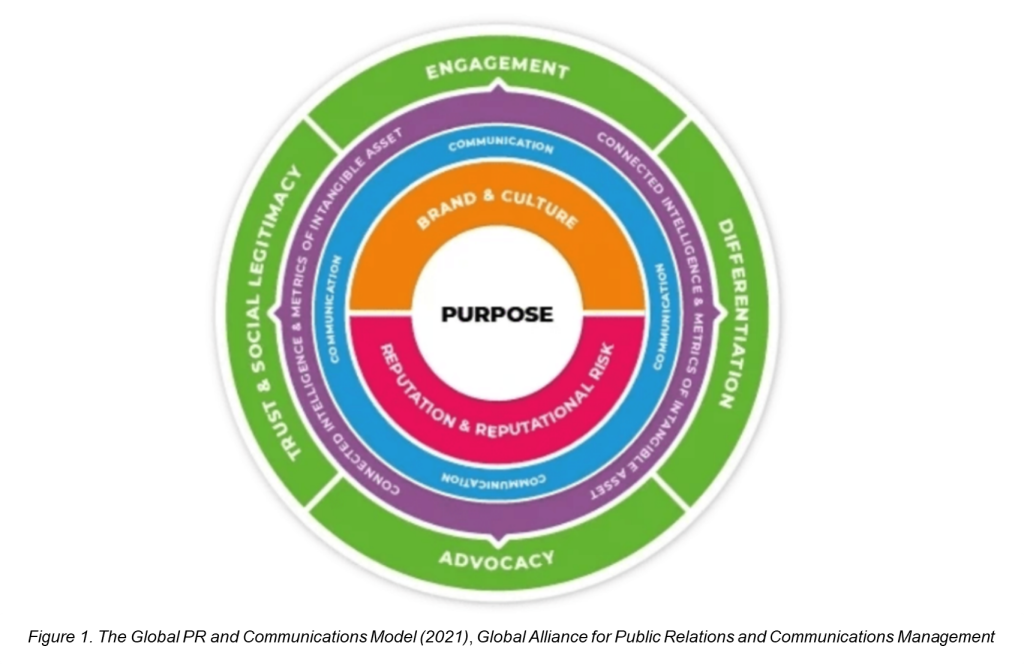What the metaverse means for PR and communications
About the author
Hassan Abul Enein prepared this article as part of a CIPR Professional PR Diploma assigment while studying with PR Academy.

Overview

On 28 October 2021, Mark Zuckerberg, announced a rebrand of Facebook Inc, with the global technological mammoth becoming Meta. The move anchored Zuckerberg and the company at the forefront of the metaverse. Other tech giants including Google and Microsoft are also investing heavily and following Zuckerberg’s suit to position themselves at the epicentre of the growing digital ecosystem. With more investments flowing into the metaverse, the ecosystem is expected to grow exponentially.
This, however, presents an opportunity and a critical risk, which needs to be unpacked by the PR and communications industry if it is to continue to add value and maximize impact. It also stresses the importance of reassessing which PR and communications model(s), will allow the industry to manoeuvre this technological shift.
What is the metaverse?
There is no universal definition of the metaverse. Nonetheless, the metaverse generally refers to a simulated and integrated digital ecosystem(s), powered by artificial intelligence and virtual and artificial reality. It is positioned between reality and fantasy and promises to fully immerse users in an interactive, decentralised, and interoperable environment. Although early in its evolution, the ecosystem is taking shape rapidly. It is also enabling people to deepen and extend social interactions, breaking down boundaries and democratizing access to key goods, services, and experiences.
Why is the metaverse important for the PR and communications industry?
Over the course of the last year, and particularly due to Covid-19, the metaverse’s potential has been accelerated, shedding light on its value. In November 2021 for example, Justin Bieber was one of the first artists to announce a concert in the metaverse. Moreover, Global fashion houses Gucci, Burberry, and Balenciaga became the first to display collections and sell digital wearables. Meanwhile, virtual property was sold on the metaverse, with the average price of a piece of virtual land doubling in six months and virtual estates selling for upwards of $450,000. Brands are also protecting their rights. MacDonalds filed for trademarks for virtual restaurants, so did Nike, who filed 7 patents for their logo and iconic trademarks such as the brand’s slogan ”Just Do It”.
Bloomberg estimates that the value of the metaverse market will reach $800 billion by 2024. With more companies expected to aggressively penetrate this digital ecosystem, and with a growing consumer interest (in the US alone, 2021 witnessed 72% of fashion consumers accessing virtual worlds, with 50% expressing an interest in purchasing digital assets), the importance and value of awareness raising, brand positioning, marketing and advertisement and ultimately crisis and reputation management, are underpinned.
With the PR and communications industry representing the driving force behind these organisational functions – whether conducted by in-house teams or external agencies – the metaverse represents a prime opportunity for the industry to drive further revenue and generate new business. It also offers an avenue to reflect on the best ways to create value and sustainable impact while communicating with a growing stakeholder base.
However, this opportunity does not come without risk. In 2019, the International Public Relations Network survey found that 58% of representatives of global agencies anticipated that digitisation is one of the biggest threats impacting the PR and communications ecosystem[1]. With the metaverse labelled as the ‘’next big tech platform’’ and with it relying heavily on digital technologies, a failure of the PR and communications industry to develop capabilities, keep up to date, and innovate, means that the industry is on a trajectory towards a slow and painful death.
The evolution of PR and communication models
PR and communications models have gone through seismic shifts throughout the years parallel to evolutions in policy, marketing, and technology. With the predicted growth of the metaverse, the importance and value of a new PR and communications model and its correlation to the survival of the industry is spotlighted.
Decades ago, individuals and organisations utilised PR and communications to position themselves, drive revenue and enhance their stature amongst the community by sharing stories that contained little to no news. The earliest examples of this included the great showman Phineas T. Barnum, who amongst other press agents and businesspeople, crafted stories that were fabricated, to promote their businesses[2]. This formed the basis of what is to be later coined as the press agentry model, which was one-way in nature and was premised heavily on the excessive use of propaganda.
With the advent of global conflict (WWI and WWII), and the growth of public interest in consuming and digesting knowledge and news due to the rise of new mediums, the PR and communications approach evolved to focus on sharing information and guide the public in a trustworthy and somehow ethical manner. The evolution of the appetite of the public (as well as the transnational events occurring in all corners of the world) resulted in the development of the public information model. This model, focused on sharing facts without the use of excessive propaganda and news manipulation[3]. It relied on and was in line with Ivy Lee’s Declaration of Principles, which sought to legitimise public relations and build trust in the industry[4].
On the other hand, the growth of public interest in organisational conduct and behaviour as well as the acceleration of the adoption of technology in day-to-day life, ushered the two-way asymmetrical and symmetrical communication models[5]. The models reinterpreted the relationship between organisations and stakeholders and by default the PR and communications industry.
The asymmetrical model focuses on persuasion, with organisational interests prioritised. It does not objectively factor in the interests of stakeholder and includes trails of the press agentry model. It does however stress collaboration and insight gathering, albeit with the objective of influencing behaviour and changing perceptions.
The two-way symmetrical model, by contrast, presents PR and communications as a strategic management function. It also emphasizes that ‘’individuals, organizations, and publics should use communications to adjust their ideas and behavior to those of others rather than try to control how others think and behave”[6]. The model heavily integrates stakeholder engagement and collaboration. It also builds on the importance and value of trust in all PR and communications activities.
Does the metaverse necessitate a new PR and communications model?
Although elements of the existing PR and communications models are used interchangeably (with the two-way symmetrical model arguably being the most frequently used today), and have been praised on a few occasions, they might not be suitable for the metaverse due to several reasons:
- Geographic reach and diverse stakeholders
The metaverse’s breadth and width is unlimited. A Gartner report published in 2022 highlights that 25% of consumers worldwide will use metaverse platforms for at least one hour daily by 2026[7]. This means that the PR and communications industry will need to deal with a massively growing number of stakeholders from diverse backgrounds and in various locations, all at once. The traditional approach incorporated by the existing models which focuses on mass communication will become obsolete with the growth of the metaverse. The PR and communications industry will need to delve further into more specific stakeholder groups, reinforcing two-way communications and proactive listening to ensure that PR and communications is effective across the digitally powered ecosystem.
- Technological acceleration and adoption
Web 1.0 and 2.0 allowed practitioners to leverage and use internet-based applications (i.e., social media and blogs) for research, distribution of communications, and forming closer relationships with stakeholders[8][9], enabling models such as the two-way symmetrical model to thrive. The metaverse, which is built on Web 3.0, however, rolls new applications and emerging technologies (AR, VR and blockchain) into one fully decentralised and interoperable world. Hence, from a PR and comms perspective, it will require much more upbeat integration and technology adoption. Rather than focusing on multimedia content primarily, the industry will need to rely on and leverage volumetric (3D) and gamified content. This is content which is tailored and prioritises user experiences, in line with what is expected of the metaverse[10]. Something that existing PR and communications models have not incorporated or used yet.
- Trust
Existing PR and communications models have sparked controversy on the value of trust. Only recently substantial conversations have emerged on the importance of trust. The topic has also not been addressed for decades. Edelman’s 2021 trust barometer for example underlines that trust in information sources is at records low, with social media and owned media securing the lowest levels of trust (35% and 41% respectively) compared to other sources[11]. The report also highlights that a failing ecosystem of government, businesses, media, and NGOs alongside information bankruptcy, is wreaking havoc globally. With the metaverse on an exponential growth trajectory, and with more information forecasted to be shared by a plethora of stakeholders in a yet to be regulated world, these trends are likely to continue. Thus, necessitating the integration and prioritisation of building trust by the PR and communications industry in its operations moving forward.
- Rapid crisis development
Across the metaverse, new types of cyberattacks, identity theft and trademark infringement will take place[12] due to the copious amounts of data the ecosystem is built on. With a plethora of users connected, many issues will also arise. Such occurrences and threats will be determinantal to organisations. The PR and communications industry, as it ventures into the metaverse, will hence now more than ever need to prioritise, an updated and fresh approach to crisis communications and response. Professionals will continuously need to predict monitor, report, and proactively respond to any challenge 24/7, wherever it comes from, whenever. Crisis communications in the metaverse will also need to leverage technologies such as artificial intelligence to sift through the vast amount of data and enhance preparedness in real-time. Existing PR and communications models do not embody this since they largely operate on a reactive rather than a proactive approach[13].
A way forward
It is evident from the above that the use of traditional PR and communications models will not allow the industry to manoeuvre the metaverse ecosystem and create sustainable value and impact. Moving forward it is therefore necessary that the industry develops and adopts a new model if it is to thrive. This model should be built on trust, prioritising authentic and bespoke connections and engagements with stakeholders, leveraging technology to analyse and act upon data and respond to crises. It should also utilise a variety of content and mediums, including volumetric and gamified content with the model’s sole objectives being creating and delivering purpose and impact.
Luckily, the recent launch of the ‘’Global PR and Communication Model’’[14] offers a promising roadmap. The model (Figure 1), which was developed by more than 1,400 professionals, is built on five building blocks and focuses on identifying and activating corporate purpose. It integrates building and developing corporate culture and brand with managing reputation and reputational risk, promoting, and enhancing two-way communications with stakeholders, and connecting intelligence and intangible asset metrics using technology.
 Although novel, and further assessment of its effectiveness will need to be undertaken in the coming years, the model could usher the necessary change in thinking for the industry to manoeuvre a continuously shifting landscape, including the rise of new ecosystems such as the metaverse. This is particularly relevant as the model aims to amalgamate PR and communications across all business and organisational functions, improving decision-making, and promoting real and authentic connections with stakeholders, while cementing differential leadership.
Although novel, and further assessment of its effectiveness will need to be undertaken in the coming years, the model could usher the necessary change in thinking for the industry to manoeuvre a continuously shifting landscape, including the rise of new ecosystems such as the metaverse. This is particularly relevant as the model aims to amalgamate PR and communications across all business and organisational functions, improving decision-making, and promoting real and authentic connections with stakeholders, while cementing differential leadership.
Notes
[1] The Changing Trend of PR Globally: An Agency Perspective (2019). International Public Relations Network. Accessible at: https://www.tdub.de/wp-content/uploads/2019/04/IPRN_Survey_2019.pdf
[2] Grunig, J.E. and Hunt, T. (1984), Managing Public Relations, Holt, Rinehart and Winston, New York, NY. P.26.
[3] Kaid, Lydna Lee. (2004), Handbook of Political Communication Research, Routledge, United Kingdom.
[4] Lee, Ivy, Declaration of Principles (1906).
[5] Grunig, J.E. and Hunt, T. (1984), Managing Public Relations, Holt, Rinehart and Winston, New York, United States.
[6] Grunig, J.E. (2006), Furnishing the Edifice: Ongoing Research on Public Relations as a Strategic Management Function, Journal of Public Relations Research, 18:2, 151-176.
[7] Gartner (2022), Predicts 2022: 4 Technology Bets for Building the Digital Future, Gartner. Accessible at: https://www.gartner.com/en/documents/4009206/predicts-2022-4-technology-bets-for-building-the-digital-future
[8] Breakenridge, Deirdre (2008). PR 2.0: New Media, New Tools, New Audiences. Pearson. United Kingdom.
[9] Wright, Donald & Hinson, Michelle. (2008). How Blogs and Social Media are Changing Public Relations and the Way it is Practiced. Public Relations Journal. 2.
[10] Hall, Stefan.B and Baier-Lentz, Moritz. (2022), 3 technologies that will shape the future of the metaverse – and the human experience. World Economic Forum, Geneva, Switzerland. Accessible at: https://www.weforum.org/agenda/2022/02/future-of-the-metaverse-vr-ar-and-brain-computer/
[11] Edelman Trust Barometer (2021). Edelman. Accessible at: https://www.edelman.com/trust/2021-trust-barometer
[12] Shandwick, Weber. (2022). Communicating In The Metaverse? Keep Your Eyes Wide Open. PRovoke Media. Accessible at: https://www.provokemedia.com/latest/article/communicating-in-the-metaverse-keep-your-eyes-wide-open
[13] Cheng, Y. (2018), How Social Media Is Changing Crisis Communication Strategies: Evidence from the Updated Literature. Journal of Contingencies and Crisis Management, 26: 58-68.
[14] Global PR and Communication Model (2021), Global Alliance for Public Relations and Communications Management. Switzerland. Accessible at: https://www.prcommsmodel.com/